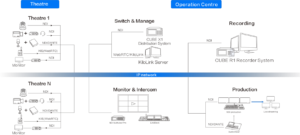Video encoder refers to a network transmission device that compresses digital video and processes audio and video data. In the process of network transmission, what is more important is the clearness of the video image and the difference in broadband between the processed video. Let ’s take a closer look at the basic concepts of video encoders:Frame rate: The so-called frame rate is the number of images in one second. The video is composed of one image. Therefore, the frame rate concept is used in the capture and playback coding. That is, the frequency (rate) of the video on the display. The higher the acquisition frame rate, the better the reduction.Bit rate: Bit rate is the concept of video transmission. It refers to the bit rate transmitted per second and the amount of data sent in one second. In real-time applications, adaptive bandwidth has always been the goal of the encoder’s bit rate control algorithm. It is the concept of compression ratio, such as the amount of binary data after a frame of video (an image) is encoded and compressed. Source code data block of K symbol size in channel codingBy encoding and mapping to a codeword of N symbol size, K / N becomes the code rate.Resolution: Resolution is the definition of video, ultra clear, high definition and the like. The most common features are:720P (ultra-clear) film source requires 4M1080P (Full HD) film source requires 8M bit stream4K (Ultra High Definition) source requires 10M bit streamLossless / lossless coding: In digital compression technology, lossless and lossless coding applications are everywhere, and the information in the transmission process is not damaged. The encoding method will completely restore the original information. This is lossless coding.code. Lossy coding is more commonly seen in the compression of multimedia information such as images, videos, audios, etc. Because the original information of multimedia information is too large, it is necessary to lose unobservable information during the encoding process, and the lost data cannot be recovered, and the compression is relatively large.H.264 / H.265 encoding: H.264 encoding is a low-latency HD video image processing algorithm and a standard H.264 video compression algorithm;H.264 can realize SD digital image transmission at a speed lower than 2Mbps, while H.265 HighProfile can realize 1080p Full HD video transmission at a transmission bandwidth lower than 1.5Mbps.H.264 encoding and H.265 encoding are both video encoding formats. Compared with H.264, H.265 can transmit higher-quality network video in a limited bandwidth, which means that only half the bandwidth of the original H.264 encoding can transmit the same quality video.










